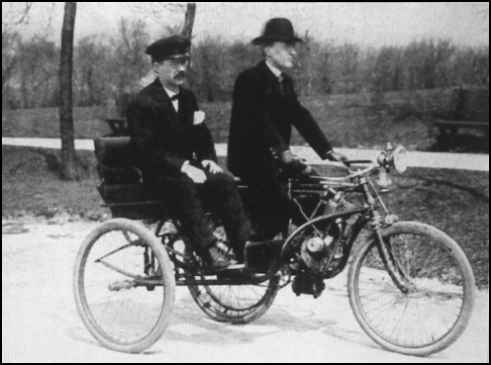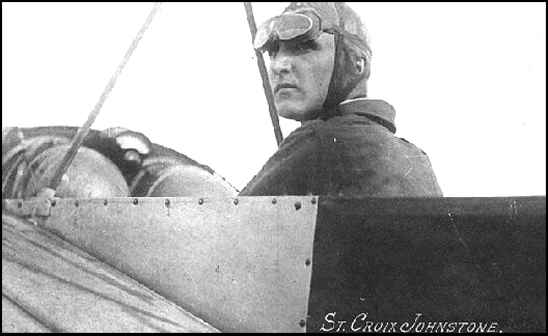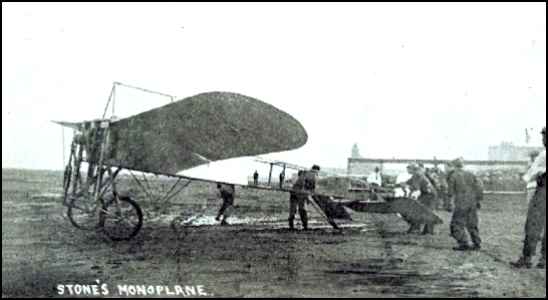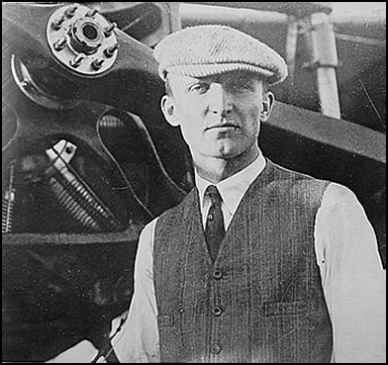
1883-1911 |
 |
|
Solid comfort in the Motorcycle Side Seat Car---St. Croix Jouhnston. Motorcycle Racer, Driving; I. H. Whipple, Motorcycle Expert in Side Car from Popular Mechanics Magazine, 1905 Courtesy of Gordon Taylor, 6-24-09 |
 |
 |
|
Photos Courtesy of Roy Nagl, 1-6-04 |
|
Windsor, Ontario., Thursday June 29, 1911 Transcribed by Gord Taylor, 4-7-05 DARING BIRDMAN MAKES BEAUTIFUL WINDSOR FLIGHT MAKES TRIP FROM STATE FAIR GROUND TO WINDSOR AND RETURN ............... FEAT SHOWS DANGER OF AIRCRAFT TO CITIES IN THE CASE OF WAR For the first time in its history a real sure enough Aviator flew his machine over Windsor and made hundreds of citizens crane their necks skywards to see a mere man triumphing over the elements. The "mere man" who turned this marvelous trick was St.- Croix Johnstone the daring Yankee aviator of the Moisant Team, who made good his promise to be the first human being to soar over the city of Detroit in a flying machine. He also took a sweep- ing circuit over Windsor. Johnstone, along with other aviators is holding forth at the Detroit State Fair grounds where an aviation meeting commenced to-day. Some days ago he promised to startle Detroit by looking down from his lofty perch in an aeroplane, and yesterday he made good in sensational fashion. The international flight was made in a monoplane, its total weight being only 650 pounds. His flight embraced 21 miles and he made the entire dis- tance in about 20 minutes which is travelling some. If the daring Birdman had met with an accident while in the air he would have suffered a drop of 2000 feet as he maintained this altitude the entire trip. The monoplane which was seen in Windsor about 7 o'clock left the state fair ground which is about 7 miles from the Majestic building in Detroit. He swung straight down Woodward Avenue and then over the river into Windsor. His machine appeared like a huge darning needle, thin and broadened a trifle in the front. He drove his machine until he reached the Hotel Dieu where the turn was made. As he swung around, Windsorites had a splendid opportunity to see the machine. The setting sun shot its rays upon the metal on the mono- plane which flashed and sparkled like a diamond in a darkened room. Several local people declare that the chugging of the motor could be distinctly heard as the machine soared gracefully over the city. It was wonderful, wonderful enthusiastically declared a Windsorite who saw the flight. "It was some thing I would not have missed for a great deal. Just think of a human being riding through the heavens, 2000 feet above the earth in a frail little craft at the rate of a mile a minute. Who says the world isn't progressing?" Johnstone is the first aviator to cross the Detroit river. While he was crossing the northern bound- ary line of the United States a boat followed him but the machine was so far removed from earth and water that its parts were not to be distinguished. Johnstone is 28 years old. He became interested in aviation in England and started to learn the art of flying in Great Britain. |
 |
|
Collection of Library of Congress, 11-18-07 |
|
Orange Lake, N.Y., August 23, 1995 Transcribed by Patricia Favata, 3-23-06 An historic flight of fancy at Orange Lake By Bo Gill They came by trolley, horse and carriage, boat, train, automobile and on foot to Orange Lake Park on Memorial Day, 1911. They stood in line to witness two spectacular and thrilling flights of a monoplane piloted by the famous birdman, St. Croix Johnstone a daring blond-haired Chicago aviator. More than 15,000 people battled their way to see for the first time in the history of the mid-Hudson a machine successfully fly through the air. The exodus from the City of Newburgh began at 9 a.m. and continued until the exhibition at 2 and 4:45 p.m. The Orange Lake Traction Co. was forced to run trolley service at frequent intervals to accommodate visitors. Ferry boats, operating on a 10-minute schedule, transported people from Dutchess County who struggled to find space on the trolleys. The West Shore Railroad brought packed passenger trains from the north and south to Newburgh. The Central Hudson River Steamboat Company's William F. Romer brought more than 400 passengers from Kingston and Poughkeepsie to the Fourth Street dock in Newburgh. Soon afterwards, a pair of 100-foot-long steamers, the Frolic of Croton and the Juliette of Ossining, added 200 more to the throng seeking transportation to Orange Lake. At 1:30 p.m. the steamer Benjamin B. Odell of the Central Hudson Line docked with more than 2,400 people from New York City and Yonkers. It seemed as if the crowd would never find a way to Orange Lake. The trolleys did not go to their north side switch in Newburgh in order to speed up the service from the riverfront. Many people walked up to Broadway to seek rides in automobiles. Long lines of automobiles stretched the entire length of all the roads leading into and out of Orange Lake. Police, however, were able to keep the crowd under control as flight time neared. At 2 p.m., the monoplane was rolled to the starting point on a dirt track opposite the Aetna Boat House. While French mechanic Robert Mercier hurriedly inspected the machine, Johnstone, attired in aviator's clothes, gave his approval for the flight. He climbed in behind the motor of the monoplane and with a few twists of the propeller, the engine hummed. As the speed of the motor increased, he signaled to the three men who were holding the machine to let him go for the takeoff. More than 30,000 eyes looked to the sky as a bewildered crowd saw the monoplane move along the ground on its bicycle wheels and gradually soar above the ground like a big bird. As the plane climbed into the air, the crowd yelled with delight, "She's off!" They could hardly believe that a man heavier than a bird was fhying through space. Their muscles grew tighter, and their blood circulated faster all the while being feaful of drawing a breath as Johnstone piloted the plane upward. It brought a startling sensation to all as Johnstone maneuvered the monoplane northeast toward Newburgh, back to the lake where he circled it and then flew north again. As he moved toward the track, the plane began to glide downward. The throng exclaimed, "He's going to land!" But the aircraft began to rise again and soared around the lake. Johnstone then guided the plane into a perfect landing; the hum of the engine became quiet, and the propeller slowed up. As the plane hit the race track, willing hands rushed to sieze it, slowing the plane until it was at a standstill. Bedlam broke out as spectators rushed to Johnstone. Crowd control was lost. Johnstone handled the situation well and said he would make another flight. He covered 13 miles in 14 minutes on the first trip. The flight brought home the fact that what had not been possible was now taking place. It was no longer a myth--but a reality. Spectators were in awe of the control that Johnstone held over the monoplane as he landed within 15 feet of where he had taken off. The second flight, covering 15 miles and taking 18 minutes, had a far more different ending. Encountering strong air currents, Johnstone was forced to seek a landing spot after taking off at 5:45 p.m. He selected a field owned by Gilbert Quick on the road leading from Orange Lake to Coldenham. He successfully landed, but conditions were not good for a takeoff. Battling what he considered to be a 25 to 1 chance, Johnstone gunned his plane but, it failed to lift off as it raced along the ground, cutting a wide swathe in the corn field. Johnstone agreed to pay Quick for the loss of the corn. The plane was towed from the cornfield back to Orange Lake. Slight damage to one of the plane's elevators was repaired and Johnstone was ready for two more flights on Sunday. He said the are was not conducive to flying, however. Ít is full of hills and valleys, and as soon as the airship passes over a low piece of land, you encounter a choppy wind that tends to draw the machine toward the ground. He said the treacherous wind made it necessary for a pilot fo find an immediate landing area. He experienced this more than 40 years before "Wings of West Point" began to train the house guests of Mr. and Mrs. Bryant Odell at their Orange Lake cottage. They dined at the Palatine Hotel on Friday and Saturday nights. During the two days, amazingly, there were no accidents, injuries or arrests. Concession stands experienced their greatest business, as the crowd spent both days watching the exhibitions that were presented for free. Not only was it the greatest day for the Orange County Traction Co. and Orange Lake Amusement Park, it was a day that saw aviation history made in the Town of Newburgh. |
|
The Story of the Early Birds by Henry Serrano Villard (page 141) |
|
by Donna P. Hubner "The Wright Exhibition Team lost its two best pilots, St. Croix Johnstone and Arch Hoxsey, only a short time after Wilbur Wright declared that he was "very much in earnest" in wanting no more stunt flights. The pilots had been trying to win a $4,000 prize offered by Michelin for the longest sustained flight of 1910." - (continued) This brief mention of St. Croix Johnstone was found on the Footprints of Flight website. You will be well rewarded if you decide to visit the site and read the entire article. You can access the site by clicking on: |


|